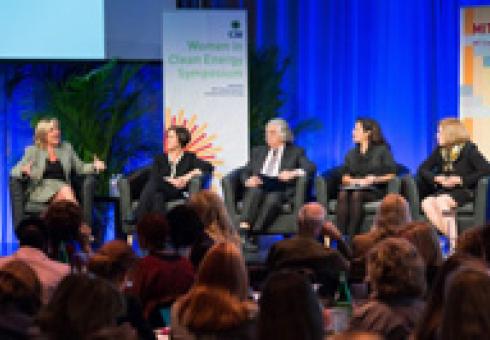News + Media
Maputo — Researchers from the Massachusetts Institute of Technology (MIT) and the United Nations have warned that Mozambique's infrastructure is vulnerable to extreme weather events that are becoming more frequent due to climate change.
According to MIT's Ken Strzepek, "in developing countries - and particularly in Africa - they are building their infrastructure at a very fast rate. They are also the most vulnerable to climate change impacts like flooding".
The researchers closely studied the projected change to Mozambique's climate and found that "it was clear that flooding and sea level rise would be two critical threats to the economy, and in particular to roads needed to transport food from rural farms to city populations".
Strzepek argues that "it would make sense for the government to spend the money now to build the roads in a way that makes them less vulnerable in the future".
Published in the "Review of Development Economics", the research on Mozambique finds that "climate change through 2050 is likely to place a drag on economic growth and development prospects. The economic implications of climate change appear to become more pronounced from about 2030. Nevertheless, the implications are not so strong as to drastically diminish development prospects".
The paper points out that "economic growth is widely held to depend on the quantity, quality, and orientation of a country's backbone infrastructure", and argues that the vulnerability of future infrastructure is "to a considerable degree, a matter of choice".
The researchers found that improved economic conditions in Mozambique have been felt by most segments of the population and that "the national poverty headcount fell from 69 to 55 per cent during 1997-2009, and infant mortality rates fell from 149 to less than 100 per 1000 births during 1996-2008. Education levels have also improved dramatically".
The authors of the report point out that "with agriculture accounting for about a quarter of Gross Domestic Product and three quarters of employment, improved rural infrastructure is often viewed as critical to future economic growth and poverty reduction".
They argue that "poor infrastructure, large distances, and associated weak market development generate large differences between farm gate and urban prices for agricultural products" and point out that "reducing these marketing margins results in strong poverty reductions, particularly if agricultural productivity rises simultaneously".
The researchers looked at four different climate change scenarios. Even in the scenario where Mozambique has a reduction in rainfall, there is a small increase in flooding although there is no increase in the probability of extreme flooding. In all the other cases, including the "global dry" scenario, the probability of extreme flooding events rises dramatically.
The paper concludes that "while the analysis conducted here does not favour a prophylactic policy of upgrading the road network, it should, in many instances, be reasonably obvious which portions of road are more likely to be subjected to flooding events. The concept extends well beyond roads. Indeed, the vulnerability profile of the large majority of the capital stock in 2050 is endogenous. By gradually channelling economic activity to areas less vulnerable to climate change (e.g. flooding events and sea level rise), the vulnerability of the economy can be greatly reduced, likely at very low cost. Simply accounting for the potential implications of climate change in decisions with respect to zoning and major public investments may be sufficient to substantially reduce the vulnerability profile in 2050 and beyond, when the implications of climate change are projected to manifest themselves with much greater force".
John Sterman, MIT Professor of Management and Director of the System Dynamics Group, discusses what happens when we elect policymakers who don't talk about science.
This is part of the MIT Museum's Climate and Conflict Series.
Read more from the Mozambique News Agency.
MIT and U.N. researchers team up to tackle some of the heftiest climate change challenges developing countries will face as they confront an uncertain future.
Higher temperatures, extreme flooding, longer droughts — for those living in the developed world, the symptoms of climate change mean building higher bridges and paying more for a bowl of cereal. But for those in low-income countries trying to grow and develop, climate change is yet another roadblock.
"In developing countries — and particularly in Africa — they're building their infrastructure at a very fast rate. They're also the most vulnerable to climate change impacts like flooding," says Ken Strzepek, a researcher with MIT's Joint Program on the Science and Policy of Global Change, who has joined forces with the United Nations University-World Institute for Development Economics Research (UNU-WIDER) to help policymakers use a holistic approach to their development strategies.
He and his MIT colleague Adam Schlosser traveled to Finland to present their research at a UNU-WIDER conference last week. The conference was an opportunity to share the results of a multi-study analysis sponsored by UNU-WIDER and released in August as a special edition version of the journal Review of Development Economics. Strzepek was a co-editor.
In their research, Strzepek and colleagues from the Universities of Copenhagen and Colorado take temperature and precipitation projections and look at how flooding, droughts and other impacts of climate change could shape factors such as crop yields, roads and energy infrastructure — all critical for a nation's growth. In doing so, they help governments in these low-income countries decide "Do we adapt now to an uncertain future? Or do we wait and potentially pay more later?" Strzepek says.
Knowing what is unknown
The researchers' main conclusion from their work is that there is so much overall uncertainty surrounding the impacts of climate change that how a country should respond depends largely on very specific factors.
Strzepek gave Tanzania as one example from his research. Like most living in developing nations, the people of Tanzania rely heavily on rain-fed agriculture. Because of the potential for increases in floods and droughts, climate change is seen as a major threat to their main source of food and income. But Strzepek found there was a very large variability in how and how much these changes could affect the country.
"You can't just go to the prime minister and say agriculture is going to go down 20 percent," says Strzepek, "there's too much uncertainty."
But there is very little uncertainty when Strzepek looked at Mozambique. There, it was clear that flooding and sea level rise would be two critical threats to the economy, and in particular to roads needed to transport food from rural farms to city populations.
"So it would make sense for the government to spend the money now to build the roads in a way that makes them less vulnerable in the future," Strzepek says.
As a third example, he studied the development of hydropower in Ethiopia, which they plan to use as an electricity export to help fund roads, schools and other social investments. In studying future impacts to hydropower, Strzepek finds that by 2050 climate change could both positively and negatively affect the energy source. But in the short term, he recommends that the government continue their plan.
"Climate change won't affect the plans that are under way now," Strzepek says. "In 15 years, we'll know a lot more about the direction of climate change and we'll be able to adapt at that time."
Strzepek found too much uncertainty to act in Tanzania, too much not to act in Ethiopia, and very little uncertainty in Mozambique. While the case studies are a needed first step at shedding light on the harsh realities of developing under climate change, much is still unclear.
With the current approach, "you can only look at the extremes," Strzepek says. "Policymakers don't like extremes or worst case scenarios because they can't afford to plan for the worst case scenarios. They like to see what is the likelihood of different outcomes."
That is the next phase of the research. Strzepek and Schlosser are beginning to use the MIT Integrated Global System Modeling (IGSM) framework, which, on a global scale, quantifies the likelihood of various climate predictions and compares them with different policies. They are now bringing this technique down to a regional scale.
Schlosser previewed this approach at the UNU-WIDER conference, while Strzepek gave an example of how it could be used.
MIT symposium highlights women’s increasing leadership in energy research, industry and government.
Female leaders are playing a growing role in advancing the development of clean-energy technologies, helping to advance plans for carbon reduction, reduce pollution and greenhouse gas emissions, and foster job creation. Some of these women were honored in a daylong symposium at MIT on Friday, Sept. 28, the inaugural event of an initiative, created in 2010 by the U.S. Department of Energy with eight partner governments, called Clean Energy Education and Empowerment, or C3E. The MIT Energy Initiative partnered with C3E to produce the symposium as well as an awards program.
MIT president emerita Susan Hockfield opened the symposium, recalling the launching of MIT’s Energy Initiative as one of her very first acts upon assuming the Institute’s presidency eight years ago. “The most important challenge for this generation,” she said, “is building a sustainable energy system for the future.”
That requires a multipronged approach, she said: “Great technology will never win alone; it needs to be paired with policy.” The key, Hockfield said, is “turning ideas into action.” When she gives talks on energy, she said, her audiences are largely male. But, she added, “Women are awfully good at turning ideas into action.”
Many of the women who were featured as speakers or who received awards at the symposium have embodied those concepts as leaders of companies, as government officials, or as researchers or educators.
One of those leaders is South Africa’s minister of energy, Elizabeth Dipuo Peters, who gave a keynote address. “The development of the clean-energy sector will revolutionize the energy sector,” she said.
In Africa, while the availability of grid-provided electricity varies greatly, overall “the proportion without access is higher than on any other continent,” Peters said. That lack of electricity, she said, “has simply crippled industrialization in Africa.” Globally, she said, about 1.5 billion people lack access to reliable electricity, which she called “a fundamental need.”
Some 85 percent of South Africans have regular access to electricity, leading the continent’s 54 nations, Peters said, adding, “People follow where the bright lights are shining.” But decentralized power systems could leapfrog traditional grids — much as the explosive growth of cellphones in the developing world has bypassed traditional telephone networks.
Nontraditional energy sources could also have a major impact in Africa, Peters said. “The ocean currents along 2,000 kilometers of coastline could meet all of our energy needs,” she said. Or, through a widespread deployment of solar power, she said, “South Africa could meet all of Africa’s energy needs.”
Africa is “poised for change,” Peters concluded. “The 21st century is indeed Africa’s century, with a bright future.”
Other speakers at the symposium echoed that call for innovative energy solutions in developing nations. Richenda Van Leeuwen, director for energy and climate at the Energy Access Initiative Team of the UN Foundation, said that “some developing countries are ahead of where we are here at home” in their efforts to develop decentralized energy systems.
Allison Archembault, president of Earthspark International, described her organization’s work to bring electricity to Haitians, only 25 percent of whom now have regular access. To remedy that, EarthSpark provides decentralized battery-charging facilities and rents out charged batteries for use in lighting, cellphone charging and other needs. Some of these customers, in turn, rent out charging capacity to their neighbors for a small fee. By displacing the kerosene most Haitians use for lighting, the organization not only cuts the cost of energy, but also eliminates a major source of indoor pollution.
Rhonda Jordan, a doctoral student in MIT’s Engineering Systems Division, described a startup called Egg Energy that has been deploying decentralized systems in Tanzania, where only 14 percent of people have access to electricity. There, she said, the issue is a “last-mile” problem: The country has a widespread electric grid, but alongside a highly inefficient distribution system and prohibitive costs. Egg Energy been targeting Tanzania’s rural homes and small businesses, providing access to power produced either by the grid or by off-grid solar power systems, which are used to charge batteries that can each provide about two days of electricity for household use.
The symposium’s speakers ranged from those working on small-scale individualized energy solutions to those working at the highest levels of government or corporations. But, these leaders pointed out, with many national and international energy plans stalled, local initiatives often are leading the way. Among other things, energy efficiency has been embraced by some states and cities, forging ahead of national standards.
Henrietta Davis, the mayor of Cambridge, said that “action on things like energy efficiency is very much on the local level,” pointing out that, besides Cambridge, cities including Boston, New York, Los Angeles and Washington have instituted efficiency programs of their own.
“The time is finally right for energy efficiency to be considered as a national strategy in itself,” said Kateri Callahan, president of the Alliance to Save Energy, which works with government officials and corporate and NGO executives to establish strategic energy plans.
One highlight of the symposium was the presentation of a Lifetime Achievement Award to Mildred Dresselhaus, Institute Professor Emerita of Physics and Computer Science and Engineering. She received tributes from two former students, one of whom called her a “bhodisatva, a bringer of enlightenment,” and another who said, “Millie changed my life,” and has “remained my mentor, ever after I left here years ago.”
MIT President L. Rafael Reif presented the award to Dresselhaus, citing her significant accomplishments in developing thermoelectric devices. “Everyone who spends a few minutes with her,” he said, “knows the brilliance of her mind.”
Six other awards were also presented, along with a student poster award selected by symposium participants.
By: Washington Post/Associated Press
The issue:
People love to talk about the weather, especially when it’s strange like the mercifully ended summer of 2012. This year the nation’s weather has been hotter and more extreme than ever, federal records show. Yet there are two people who aren’t talking about it, and they both happen to be running for president.
Where they stand:
In 2009, President Barack Obama proposed a bill that would have capped power plant carbon dioxide emissions and allowed trading of credits for the right to emit greenhouse gases, but the measure died in Congress. An international treaty effort failed. Obama since has taken a different approach, treating carbon dioxide as a pollutant under the law. He doubled auto fuel economy standards, which will increase the cost of cars but save drivers money at the pump. He’s put billions of stimulus dollars into cleaner energy.
Mitt Romney’s view of climate change has varied. In his book “No Apology,” he wrote, “I believe that climate change is occurring” and “human activity is a contributing factor.” But on the campaign trail last year he said, “We don’t know what’s causing climate change on this planet.” He has criticized Obama’s treatment of coal power plants and opposes treating carbon dioxide as a pollutant and the capping of carbon dioxide emissions, but favors spending money on clean technology. Romney says some actions to curb emissions could hurt an already struggling economy.
Why it matters:
It’s worsening. In the U.S. July was the hottest month ever recorded and this year is on track to be the nation’s warmest. Climate scientists say it’s a combination of natural drought and man-made global warming. Each decade since the 1970s has been nearly one-third of a degree warmer than the previous one.
Sea levels are rising while Arctic sea ice was at a record low in September. U.S. public health officials are partially blaming unusually hot and dry weather for an outbreak of the deadly West Nile virus that is on pace to be the worst ever. Scientists blame global warming for more frequent weather disasters, with the World Health Organization saying: “Climatic changes already are estimated to cause over 150,000 deaths annually.” Others put the toll lower.
Emissions of carbon dioxide and other greenhouse gases from the burning of fossil fuels are trapping more of the sun’s heat on Earth. One study showed that 97 percent of the scientists who publish about climate in peer-reviewed journals say global warming is man-made. So do just about every major science society and institution that has weighed in.
But limiting carbon dioxide emissions from coal and oil would be costly, with billions of dollars in changes to the U.S. economy only a starting point. Similarly the price of not doing anything is extraordinarily high because of costly and deadly extreme weather. People will pay either way in taxes, energy prices, insurance premiums, disaster relief, food prices, water bills and changes to our environment that are hard to put a price tag on, says MIT economist Henry Jacoby.
A NASA study this year found the most extreme type of weather, which statistically should happen on less than 0.3 percent of the Earth at any given time, is now more common. Until recently, the most extreme year was in 1941 when extremes covered 2.7 percent of the globe. From 2006 to 2011 about 10 percent of the globe had that extreme weather, with a peak of 20 percent, the study said. That was before this year’s record extremes started.
The issue of man-made global warming is “totally missing” from the campaign between Obama and Romney, says Jacoby. It should be talked about, he says, because “we’re running a serious risk of passing a much-damaged planet to our descendants.”
Atmospheric science pioneer Susan Solomon speaks on past environmental accomplishments, technology’s role and how history should be our guide to meeting today’s global challenges.
By: Vicki Ekstrom Few can speak with as much authority on the topic of environmental success as Susan Solomon.
Few can speak with as much authority on the topic of environmental success as Susan Solomon.
An MIT professor of atmospheric chemistry and climate science, Solomon was the first to identify the chemical process that causes the ozone hole, and she made some of the first measurements in Antarctica demonstrating that chlorine-containing chemicals that used to be in refrigerators and spray cans are the cause of ozone depletion.
In a Sept. 13 talk, Solomon used the phasing out of these chemicals, known as chlorofluorocarbons (CFCs), as well as the phasing out of lead in indoor paint and gasoline, as successful examples from which the world could learn how to meet today's most critical global challenge: climate change.
VIDEO: Watch the event
CFCs and lead were phased out mainly because of the clear evidence of their danger and strong public understanding of personal health impacts, explained Solomon, who came to MIT last year from the U.S. National Oceanic and Atmospheric Administration and the University of Colorado.
In the case of CFCs, the real reason they were able to be phased out "was because of us," Solomon said.
"Most of these CFCs came from spray cans everyone was using for hairspray and deodorant, so one of the primary sources was literally in your medicine cabinet at home."
When two chemists found that CFCs might deplete the ozone layer and increase risks of skin cancer, "that was enough to get people concerned … [and] it wasn't that difficult to make the change. All you had to do was 'get on the stick,'" Solomon said, parodying a well-known advertisement from that era.
"The key thing that this did was take something that had been very good business and turn it into bad business," Solomon said. To meet the shifting consumer demand, "technological successes were achieved in sector after sector where chlorofluorocarbons were used." Public understanding and action spurred the technological advancements that paved the way to success. But gaining that broad public support isn't always easy.
Public understanding and action spurred the technological advancements that paved the way to success. But gaining that broad public support isn't always easy.
In the case of lead, the trail of scientific evidence warning of health impacts went back as far as the Roman Empire, and perhaps even further. Yet it took many centuries before real action was taken.
"One of the reasons we were slow in doing something about lead was because of scientists who were skeptics," Solomon said, displaying a clear parallel to the climate change issue.
In the end, it was civil rights that spurred public engagement, as poor African American children living in deteriorating housing and near highways were found to have higher levels of lead in their blood, Solomon said.
Solomon also pointed out that the developed world had the infrastructure and institutions to make these changes possible.
"It's easy to knock the EPA these days, but the EPA, FDA, Consumer Product Safety Commission, those are all organizations that we have to thank."
Today's environmental challenge: climate change
Many of the underlying health and human rights concerns from the past are alive today, as the world confronts climate change.
The ethical dimension is especially disturbing, and it's making the problem even more complex and difficult to address. Solomon explained that the average person in the developed world emits a 1,000 times more emissions than the average person in Chad, 200 times more than those in Ethiopia, 80 times more than those in Kenya, and 20 times more than those in India.
"Six billion live in the developing world and they emit about five times less CO2 per person than the one billion of us in the developed world," Solomon said.
At the same time, those countries want to grow and develop. If they choose to grow using fossil fuels like the developed world, global emissions will go up significantly.
"So the key question, the key sustainability issue is, what about those peoples' future?" she said. "Should China pay more to develop than we did? Should Africa?
Such questions aren't sparking the same level of public engagement the world saw before phasing out lead and CFCs, but Solomon thinks they should. "We're in the developed world, we have air conditioning, we have comfortable lives, we have to think beyond us."
"We're in the developed world, we have air conditioning, we have comfortable lives, we have to think beyond us."
While Solomon notes that she personally takes the bus and does what she can to reduce the amount she emits, she's not fooling herself into believing that such actions from everyone will be enough.
"This issue will not be solved by giving up your spray deodorant, this issue won't be solved by taking the bus," Solomon says. "The problem is much bigger."
With no one silver bullet on the horizon, Solomon says research on many different approaches is critical. That could include research on reducing deforestation, increasing wind and solar power, using more efficient cars and building techniques, expanding nuclear, gas and biofuel energy, or employing carbon capture and storage techniques.
To gain this fundamental research and development will require a "bottoms-up technology policy where we start as consumers saying we need a space race for energy technology," Solomon says. "That's what I think we need because engineering and technology has to pave the way. That's why I'm at MIT."
Study estimates rate of intensification of extreme tropical rainfall with global warming.
By: Jennifer Chu, MIT News Office Extreme precipitation in the tropics comes in many forms: thunderstorm complexes, flood-inducing monsoons and wide-sweeping cyclones like the recent Hurricane Isaac.
Extreme precipitation in the tropics comes in many forms: thunderstorm complexes, flood-inducing monsoons and wide-sweeping cyclones like the recent Hurricane Isaac.
Global warming is expected to intensify extreme precipitation, but the rate at which it does so in the tropics has remained unclear. Now an MIT study has given an estimate based on model simulations and observations: With every 1 degree Celsius rise in temperature, the study finds, tropical regions will see 10 percent heavier rainfall extremes, with possible impacts for flooding in populous regions.
“The study includes some populous countries that are vulnerable to climate change,” says Paul O’Gorman, the Victor P. Starr Career Development Assistant Professor of Atmospheric Science at MIT, “and impacts of changes in rainfall could be important there.”
O’Gorman found that, compared to other regions of the world, extreme rainfall in the tropics responds differently to climate change. “It seems rainfall extremes in tropical regions are more sensitive to global warming,” O’Gorman says. “We have yet to understand the mechanism for this higher sensitivity.”
Results from the study are published online this week in the journal Nature Geoscience.
A warm rain will fall
Global warming’s effect on rainfall in general is relatively well-understood: As carbon dioxide and other greenhouse gases enter the atmosphere, they increase the temperature, which in turn leads to increases in the amount of water vapor in the atmosphere. When storm systems develop, the increased humidity prompts heavier rain events that become more extreme as the climate warms.
Scientists have been developing models and simulations of Earth’s climate that can be used to help understand the impact of global warming on extreme rainfall around the world. For the most part, O’Gorman says, existing models do a decent job of simulating rainfall outside the tropics — for instance, in mid-latitude regions such as the United States and Europe. In those regions, the models agree on the rate at which heavy rains intensify with global warming.
However, when it comes to precipitation in the tropics, these models, O’Gorman says, are not in agreement with one another. The reason may come down to resolution: Climate models simulate weather systems by dividing the globe into a grid, with each square on the grid representing a wide swath of ocean or land. Large weather systems that span multiple squares, such as those that occur in the United States and Europe in winter, are relatively easy to simulate. In contrast, smaller, more isolated storms that occur in the tropics may be trickier to track.
An intensity of extremes
To better understand global warming’s effect on tropical precipitation, O’Gorman studied satellite observations of extreme rainfall between the latitudes of 30 degrees north and 30 degrees south — just above and below the Equator. The observations spanned the last 20 years, the extent of the satellite record. He then compared the observations to results from 18 different climate models over a similar 20-year period.
“That’s not long enough to get a trend in extreme rainfall, but there are variations from year to year,” O’Gorman says. “Some years are warmer than others, and it’s known to rain more overall in those years.”
This year-to-year variability is mostly due to El Niño — a tropical weather phenomenon that warms the surface of the Eastern Pacific Ocean. El Niño causes localized warming and changes in rainfall patterns and occurs independent of global warming.
Looking through the climate models, which can simulate the effects of both El Niño and global warming, O’Gorman found a pattern. Models that showed a strong response in rainfall to El Niño also responded strongly to global warming, and vice versa. The results, he says, suggest a link between the response of tropical extreme rainfall to year-to-year temperature changes and longer-term climate change.
O’Gorman then looked at satellite observations to see what rainfall actually occurred as a result of El Niño in the past 20 years, and found that the observations were consistent with the models in that the most extreme rainfall events occurred in warmer periods. Using the observations to constrain the model results, he determined that with every 1 degree Celsius rise under global warming, the most extreme tropical rainfall would become 10 percent more intense — a more sensitive response than is expected for nontropical parts of the world.
“Unfortunately, the results of the study suggest a relatively high sensitivity of tropical extreme rainfall to global warming,” O’Gorman says. “But they also provide an estimate of what that sensitivity is, which should be of practical value for planning.”
The results of the study are in line with scientists’ current understanding of how global warming affects rainfall, says Richard Allan, an associate professor of climate science at the University of Reading in England. A warming climate, he says, adds more water vapor to the atmosphere, fueling more intense storm systems.
"However, it is important to note that computer projections indicate that although the rainfall increases in the wettest regions — or similarly, the wet season — the drier parts of the tropics … will become drier still,” Allan says. “So policymakers may have to plan for more damaging flooding, but also less reliable rains from year to year.”
Susan Solomon, the Ellen Swallow Richards Professor of Atmospheric Chemistry and Climate Science, discusses "The World's Chemistry In Our Hands: Global Environmental Challenges Past and Future" as part of the MIT School of Science's Dean Colloquium Series.
By: Michael Vaughan
Two interesting issues that in the banality of the U.S. presidential campaign will likely never be discussed:
1. the extent of the sea ice covering the Arctic Ocean is now the smallest observed in the three decades since consistent satellite observations of the polar cap began, according to scientists from NASA;
2. an important study finds a carbon tax would enable the United States to find the means to both close the deficit gap and revive the economy.
While the two contenders are slanging each other about tax returns and birth certificates both surely know that NASA and MIT have to be taken seriously. Mitt Romney (not MIT) made his fortune in Boston and Barack Obama went to Harvard. MIT (Massachusetts Institute of Technology) has more new technology patents than most countries on Earth. Harvard has been lucky enough to have had among its alums a well-known billionaire who created Facebook plus eight who have became President of the United States.
When evidence becomes undeniable you have to wonder why those who make big decisions won’t discuss the evidence. Intelligent public policy matters. Yet the news is always obsessed about whether the teachers get their new raise or not. Meanwhile there are policy options that make a huge amount of sense that are never discussed, or even mentioned, in the daily news cycle.
The MIT study found that taxing carbon at $20 a ton in the U.S. would generate $1.5-trillion in revenue in a 10-year period, which would reduce corporate and personal income taxes, maintain social services spending and reduce the deficit.
“With the carbon tax there are virtually no serious trade-offs. Our analysis shows the overall economy improves, taxes are lower and pollution emissions are reduced,” said John M. Reilly, co-director of MIT’s Joint Program on the Science and Policy of Global Change. The study said the carbon tax would lower pollution by 20 per cent by 2050 and prevent oil imports from rising. It would also, most importantly, shift energy markets to clean technology.
Some Republications are coming around to the fact that the United States is facing the expiration of the “Bush” tax cuts in 2013 – the fiscal cliff. Even supply-side economists are reluctantly embracing a fee on carbon emissions. There are many global warming deniers in the GOP but others believe if the U.S. needs to raise revenue, why not just tax global warming pollution? The MIT analysis suggests that a carbon tax would be a more economically beneficial way of raising revenue than payroll or income taxes.
Additionally, the MIT report argues that a carbon tax would accomplish other important objectives. Fossil-fuel use would go down, oil imports would shrink slightly and U.S. carbon-dioxide emissions would decline. A carbon tax is tax levied on all carbon content of fuels. Carbon dioxide is a heat-trapping "greenhouse" gas. Carbon is present in hydrocarbon fuels – coal, petroleum, and natural gas – and is released as carbon dioxide (CO2) when they are burned. In contrast, non-combustion energy sources – wind, sunlight, hydropower and nuclear – do not convert hydrocarbons to CO2.
Yet, even with a carbon tax, the United States would still fall short of its long-term climate goals, which involve an 80 per cent cut in emissions below 1990 levels by mid-century. According to MIT calculations, a modest carbon tax, on its own, wouldn’t get the United States close to that longer-term mark; however, it would still make sense as a more economically efficient way of raising revenue.
If an intelligent public policy can improve the economy, reduce trade deficits, help the environment and keep the U.S. from going broke – why wouldn’t it at least be discussed in the election of the so-called most powerful person on Earth?
MIT researchers have built a model that will be further developed as part of an NSF-funded project to track how chemicals get to remote Arctic environments.
By: Vicki Ekstrom
Listen to researcher Noelle Selin on Alaska's KNOM radio here (segment begins at 3m 42s) It's been more than a decade since global leaders met in Stockholm, Sweden, to sign a treaty with the goal of eliminating persistent organic pollutants making their way into our food chain — such as harmful pesticides like DDT that nearly wiped out the American Bald Eagle. While leaders have come a long way in restricting these types of pollutants, contamination of the Arctic remains a problem. Researchers at MIT are working to help inform policies that more effectively address contamination problems with their latest research and the help of a new grant from the National Science Foundation.
It's been more than a decade since global leaders met in Stockholm, Sweden, to sign a treaty with the goal of eliminating persistent organic pollutants making their way into our food chain — such as harmful pesticides like DDT that nearly wiped out the American Bald Eagle. While leaders have come a long way in restricting these types of pollutants, contamination of the Arctic remains a problem. Researchers at MIT are working to help inform policies that more effectively address contamination problems with their latest research and the help of a new grant from the National Science Foundation.
"Persistent organic pollutants are chemicals of substantial international concern," Noelle Selin, the project's lead researcher and assistant professor in MIT's Engineering Systems Division and Department of Earth, Atmospheric and Planetary Sciences, says. "For emerging contaminants in the Arctic, we need to know more about their sources, environmental behavior, and transport pathways in order to regulate them more effectively."
Selin and Carey Friedman, a postdoctoral associate at the MIT Joint Program on the Science and Policy of Global Change, had their latest results published last week in the journal Environmental Science & Technology. The study, Long-Range Atmospheric Transport of Polycyclic Aromatic Hydrocarbons: A Global 3-D Model Analysis Including Evaluation of Arctic Sources, describes the researchers' development of a detailed 3-D atmospheric model used to track the day-to-day transport of chemicals. Specifically, they tracked PAHs — toxic byproducts of burning wood, coal, oil and other forms of energy that remain in the atmosphere for less time than other persistent organic pollutants regulated by global standards.
"Even though our model estimates lifetimes less than a day, that's still long enough for these PAHs to travel long distances and have potentially damaging effects," says Friedman, the study's lead author, noting that some of these chemicals are known carcinogens that could cause cancer. "So PAHs may be a good case study of how we regulate long-range transport."
Friedman's work will be an important foundation for ongoing work in Selin's research group at MIT, in collaboration with the University of Rhode Island and the Harvard School of Public Health. Together the researchers will be exploring the global transport of other contaminants in the Arctic, such as chemicals used in stain-resistant carpets and non-stick pans. In research going forward, Selin and her team will extend the model created in their recent analysis that allows them to track chemicals with much greater precision.
"These more complex models are showing what simple models aren't, such as daily fluctuations of pollutants in specific locations," Friedman says. "So while the simple models are important for some aspects of the policy process, they may not provide enough information to base these types of important decisions off of."
The presence of these pollutants in the Arctic is important for several reasons. First, the researchers say there's a very real health concern. Organic pollutants typically condense and rain down into Arctic regions. Once they mix with other chemicals, it's unknown what danger they could pose to animals and humans, especially in concert with climate change stressors in the Arctic. Already, these chemicals are known to build up in the fat of whales, seals and other animals — a main source of food for people living in these high latitude regions.
At the same time, the practices that create some of these chemicals such as gas and oil exploration and shipping are expected to increase in the Arctic. As they do, it's important to understand how pollutants traveling from distant sources exacerbate the problem, and how climate changes can affect future contamination.
"Climate change and contaminants are both substantial present and future threats to the Arctic, and our research can ultimately help leaders make better policies to protect this unique environment," Selin says.
By: Kieran Mulvaney
As we approach the peak of this year's hurricane season, one question that is frequently asked - particularly in the wake of this summer's succession of extreme weather events - is whether hurricanes are becoming, or will become, more frequent or stronger as climate change strengthens its grip.
It's a question with which atmospheric scientists have been grappling for a relatively short amount of time, and as such the answer is something of a moving target. Were we to consult a climatological Magic 8 Ball, we might get a response like, ‘Outlook Uncertain, But Becoming Clearer.'
So we decided to do better and turn to one of the foremost authorities on the subject, Professor Kerry Emanuel of the Department of Earth, Atmospheric and Planetary Sciences at the Massachusetts Institute of Technology. Named one of Time Magazine's 100 Most Influential People in 2006, Prof. Emanuel has published extensively on the possible linkages between tropical storms and a warming planet, and he guided us through the complex haze of theory, modeling and observation.
DNews: At the risk of asking you to distill complex science into a simplistic soundbite: Is climate change affecting the number and intensity of cyclones and hurricanes?
Kerry Emanuel: Most of us think that we are seeing a climate change signal in the North Atlantic, which is by far the best observed and has been observed for the longest period of time; but I hasten to add that only about 12 percent of the world’s tropical cyclones occur in the Atlantic. The other parts of the world are not so well observed.
What we expect from a combination of theory and modeling is that as the climate warms, the actual total number of these storms should decline globally, but the incidence of the severe Category 3, 4 and 5 storms is expected on the other hand to go up. And we do see some indication that the proportion of hurricanes that are intense around the world has been going up, although our data is a bit tenuous and is not for very long, so nobody has a great deal of confidence in it.
Let me add that, historically it’s the Category 3, 4 and 5 hurricanes that do the vast majority of damage, at least in developing countries, so those are the ones we’re concerned about the most.
DNews: Is the theory behind this simply that a warming ocean provides greater energy for these storms to feed on? Is that a fair assessment?
Kerry Emanuel: It’s almost fair. What drives hurricanes is the flow of heat from the ocean to the atmosphere, and that is proportional to the difference between the heat content of the two, rather than the absolute temperature in either of them. But it turns out that if you add greenhouse gases to the atmosphere – or indeed, if you were just able to increase the amount of sunlight coming in, one way or the other – that increases the difference and so increases the potential for hurricanes, so that they could become stronger, at least theoretically.
DNews: And what would be the reason for the overall number of storms decreasing?
Kerry Emanuel: This is an interesting question. It bears on a related question, which is, ‘Why don’t we have hurricanes everywhere all the time?’ And the fact is that hurricanes are, fortunately for us, fairly rare. And yet, the conditions for hurricanes are prevalent over much of the tropics through much of the year. We’ve learned in recent decades that what stops most ordinary, run-of-the-mill disturbances from turning into hurricanes is the relative dryness of the atmosphere a couple of miles above the surface. Normally, it’s pretty dry there, but the relevant quantity is the difference between how much water is there, and how much water could be there if the air were saturated, and we call that the saturation deficit. And that deficit increases with temperature.
And because of that, as the temperature gets warmer and warmer, ironically it becomes more difficult to start a hurricane, even though once you start a hurricane, potentially it can become more intense, so you have these two contradictory things going on.
DNews: You mentioned that there is some indication tentatively of some greater intensity in the North Atlantic. Is that a consequence of better data and record-keeping in the North Atlantic, or would one expect a distinction between storms in the North Atlantic and other oceans?
Kerry Emanuel: I wish I could answer that question. I think the data in certain other places, like the western part of the North Pacific Ocean, at times in the past was better than today. We surveyed a lot of those storms with aircraft in the period between about 1945 and 1987, when that stopped for budgetary reasons. And we don’t see such a tight connection between hurricane power and temperature in the western North Pacific that we see in the Atlantic.
We’re not quite sure what is so special about the Atlantic. There are some indications that in the Atlantic kind of an alignment goes on. There are a lot of different things that affect hurricanes, not just temperature. The change in the incidence and intensity of hurricanes in the North Atlantic has been dominated more by temperature, by thermodynamics, whereas in other parts of the world some of these other factors, which are varying quite differently, may be more influential.
I should emphasize that it’s a young science, this connection between hurricanes and climate. We’re making progress and we are beginning to see a consensus developing in certain parts of the problem, but there is still a lot of it we don’t understand.
DNews: You anticipated my next question, which is: is there coming a time when you expect you will have enough of a data set to feel increasingly comfortable with these conclusions?
Kerry Emanuel: Well, the answer is a guarded yes. I think when it comes to the global levels of activity around the world, I can see light at the end of the tunnel, that we may indeed arrive at a consensus. When, on the other hand, it comes down to measures of hurricane activity that people care about – for example, the frequency of landfall of intense hurricanes in North America – whenever you get down to that telescopic level of detail, the models inevitably disagree violently with each other, and so scientists are left without much to go on.
And so when it comes to forecasting the things that people really care about, I don’t think there’s going to be much consensus about that for a very long time. We’re going to form a very strong consensus maybe about things that don’t really matter to people. After all, who really cares how many hurricanes occur in the Atlantic Ocean? We’re really only concerned at the end of the day with landfalling intense storms, and when you get down to that level, all bets are off at the moment.
DNews: My final question then is one you’re probably not comfortable with answering: Assuming a business-as-usual scenario of fossil fuel emissions, do you feel confident in predicting how the intensity and frequency of hurricanes in, say, 2050 might look compared to 2012, or is that a prediction you’re not comfortable with making?
Kerry Emanuel: I’m not comfortable with any predictions. Seeing into the future is pretty tough. I think we have to look at this problem from the point of view of ‘what does society do, and how do we react to this’? As a problem of risk. There’s a rsk that we’re going to have more intense hurricanes. We do know that there is terrific year-to-year volatility with hurricanes; that’s true in the present climate, it will be true in a future climate. So much so that, even if there were a strong global warming signal, we might see it right away in looking at metrics over the entire North Atlantic region, but when we look at metrics that we care about, like hurricane damage – which is caused by a tiny fraction of those events – we would need to wait decades before we see a signal in that.
So we’re in an awkward position. I think hurricane scientists are becoming better and better and better at looking for keys under the lamp, and eventually we’ll find them. But the things people care about aren’t under the lamp, and it will be a long time before we find those.
Let me mention one more thing, and that is that one aspect of hurricanes that people don’t talk about enough is rain. Historically, that’s been a very big killer: for example, the second-most-deadly hurricane in the western hemisphere was Mitch in 1998, and that (deadliness) was entirely due to freshwater flooding. We’ve seen recent examples in the US with Irene last year and Isaac this year. There’s a uniform consensus – one of the few things that we all agree on in hurricane science – that warming the atmosphere will increase the rainfall from hurricanes, and that should be a major concern.
IMAGES:
Hurricane Michael -- seen here on Sept. 6, 2012, with winds of 115 mph, in high resolution infrared imagery from the NOAA/NASA Suomi NPP satellite, was the first Atlantic storm of the 2012 season to reach Category 3 intensity. (NOAA)
Hurricane Isaac video grab (Whitney Shefte/The Washington Post)










